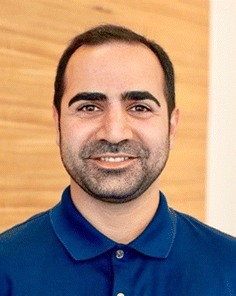Nanoscale Horizons Emerging Investigator Series: Dr Mohammad Malakooti, University of Washington, USA
Abstract
Our Emerging Investigator Series features exceptional work by early-career nanoscience and nanotechnology researchers. Read Mohammad Malakooti’s Emerging Investigator Series article ‘Green synthesis of iron-doped graphene quantum dots: an efficient nanozyme for glucose sensing’ (https://doi.org/10.1039/D4NH00024B) and read more about him in the interview below.
Dr Mohammad Malakooti is an assistant professor of mechanical engineering at the University of Washington, Seattle. He leads the iMatter Lab, a research group dedicated to creating materials that match the extraordinary adaptability, rich multi-functionality, and embodied intelligence of natural material systems. He received his PhD at the University of Florida in 2015, and a postdoctoral fellowship at the University of Michigan (2015–2017), and was a Research Scientist at Carnegie Mellon University (2017–2019).
Read Mohammad’s Emerging Investigator Series article ‘Green synthesis of iron-doped graphene quantum dots: an efficient nanozyme for glucose sensing’ (https://doi.org/10.1039/D4NH00024B) and read more about him in the interview below:
NH: Your recent Nanoscale Horizons Communication describes a method to synthesise Fe–N central single-atom doped graphene quantum dot nanozymes using a one-step solvothermal process and their applications as a colorimetric glucose sensor. How has your research evolved from your first article to this most recent article and where do you see your research going in future?
MM: My group has been working on wearable devices and stretchable electronics, with the ultimate goal of improving people’s daily lives and health. While developing machine learning methods for reliable colorimetric sweat sensing, we recognized the need to improve sensitivity. This led us to collaborate with my colleague, Prof. Miqin Zhang, to explore the use of graphene quantum dots as an efficient nanozyme. In this recent paper, we demonstrated a simple one-step synthesis process that enhances colorimetric sensitivity to low glucose concentrations, which we believe will significantly advance this research area. The next step will involve integrating these quantum dots into biosensors and studying their long-term stability and performance to assess their full potential.
NH: How do you feel about Nanoscale Horizons as a place to publish research on this topic?
MM: Nanoscale Horizons is an ideal venue, offering high visibility to an interdisciplinary audience interested in innovative nanotechnology, like our work on nanozymes and wearable sensors. I believe it brings together researchers from diverse fields.
NH: What aspect of your work are you most excited about at the moment?
MM: This is a tough question because it’s hard to choose just one aspect. Right now, I’m particularly excited about our efforts at the intersection of materials science, mechanics, and machine learning. This work has the potential to unlock new possibilities for materials and drive the development of emerging technologies, such as wearables.
NH: In your opinion, what are the most important questions to be asked/answered in this field of research?
MM: In my opinion, the most important question is how to bridge the gap between advanced materials – such as graphene quantum dots – and their real-world applications. This requires both a fundamental understanding of these materials and the development of innovative fabrication and integration methods to realize their full impact.
NH: What do you find most challenging about your research?
MM: My research is highly multidisciplinary, spanning from materials synthesis to device fabrication and characterization, which can be time-consuming and may seem like the most challenging aspect. However, I’m optimistic that the new modeling tools and frameworks we’re developing will accelerate this process.
NH: In which upcoming conferences or events may our readers meet you?
MM: I will be attending the MRS Spring Meeting and the ASME Conference on Smart Materials, Adaptive Structures, and Intelligent Systems (SMASIS).
NH: How do you spend your spare time?
MM: It depends! I enjoy travelling, spending time with family and friends, and reading non-academic books. In the spring and summer, I particularly love gardening and hiking.
NH: Can you share one piece of career-related advice or wisdom with other early career scientists?
MM: Let your passion and scientific curiosity guide your journey.
| This journal is © The Royal Society of Chemistry 2024 |

